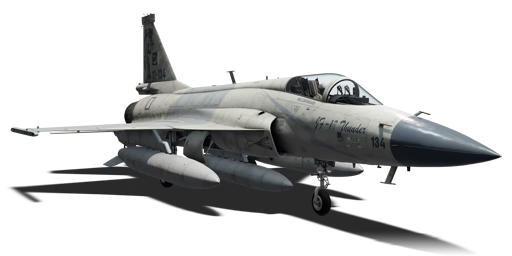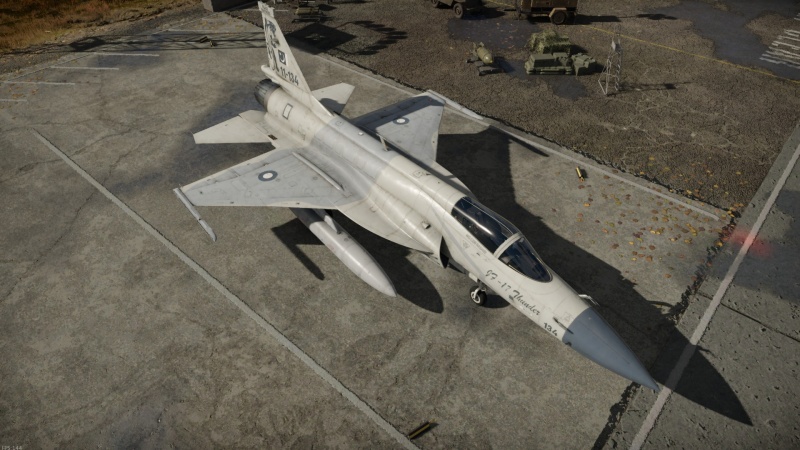JF-17
Contents
Description
The JF-17 Thunder is a squadron rank VIII Chinese strike aircraft with a battle rating of 13.3 (AB/RB/SB). It was introduced in Update "Dance of Dragons".
General info
Flight performance
Describe how the aircraft behaves in the air. Speed, manoeuvrability, acceleration and allowable loads - these are the most important characteristics of the vehicle.
| Characteristics | Max speed (km/h at _,___ m) |
Max altitude (metres) |
Turn time (seconds) |
Rate of climb (metres/second) |
Take-off run (metres) | |||
|---|---|---|---|---|---|---|---|---|
| AB | RB | AB | RB | AB | RB | |||
| Stock | ___ | ___ | 15240 | __._ | __._ | __._ | __._ | ___ |
| Upgraded | ___ | ___ | __._ | __._ | __._ | __._ | ||
Details
| Features | |||||
|---|---|---|---|---|---|
| Combat flaps | Take-off flaps | Landing flaps | Air brakes | Arrestor gear | Drogue chute |
| X | ✓ | ✓ | ✓ | X | ✓ |
| Limits | ||||||
|---|---|---|---|---|---|---|
| Wings (km/h) | Gear (km/h) | Flaps (km/h) | Max Static G | |||
| Combat | Take-off | Landing | + | - | ||
| 0 | 500 | - | 450 | 450 | ~__ | ~__ |
| Optimal velocities (km/h) | |||
|---|---|---|---|
| Ailerons | Rudder | Elevators | Radiator |
| < ___ | < ___ | < ___ | - |
Engine performance
| Engine | Aircraft mass | |||||
|---|---|---|---|---|---|---|
| Engine name | Number | Basic mass | Wing loading (full fuel) | |||
| Klimov RD-93 | 1 | _,___ kg | ___ kg/m2 | |||
| Engine characteristics | Mass with fuel (no weapons load) | Max Gross Weight | ||||
| Weight (each) | Type | _m fuel | __m fuel | __m fuel | ||
| 1,050 kg | Jet | _,___ kg | _,___ kg | _,___ kg | _,___ kg | |
| Maximum engine thrust @ 0 m (RB/SB) | Thrust to weight ratio @ 0 m (___%/WEP) | |||||
| Condition | 100% | ___%/WEP | _m fuel | __m fuel | __m fuel | MGW |
| Stationary | 3,630 kgf | 6,590 kgf | _.__ | _.__ | _.__ | _.__ |
| Optimal | ___ kgf (_ km/h) |
___ kgf (_ km/h) |
_.__ | _.__ | _.__ | _.__ |
Survivability and armour
Examine the survivability of the aircraft. Note how vulnerable the structure is and how secure the pilot is, whether the fuel tanks are armoured, etc. Describe the armour, if there is any, and also mention the vulnerability of other critical aircraft systems.
Modifications and economy
Armaments
| Ballistic Computer | ||||
|---|---|---|---|---|
| CCIP (Guns) | CCIP (Rockets) | CCIP (Bombs) | CCRP (Bombs) | EEGS |
| |
|
|
|
|
Offensive armament
The JF-17 is armed with:
- 1 x 23 mm Type 23-3 cannon, belly-mounted (200 rpg)
- 64 x large calibre countermeasures
The JF-17 is armed with a copy of the Soviet GSh-23L autocannon with 200 rounds of ammunition, familiar to any pilots who have flown the MiG-23 Flogger or J-8 Finback. It has a quick rate of fire with no spool-up time, but its low muzzle velocity and ammo count leaves something to be desired on an aircraft that routinely fights agile fourth-generation fighters. Making matters more difficult is that the gun placement underneath the left air intake is quite off-center and the JF-17 currently does not have an EEGS system like the J-8F. Less experienced users may be better off reserving the gun for low-speed engagements or anti-helicopter/anti-ground activities.
Suspended armament
| Default weapon presets | |
|---|---|
| |
While the JF-17 as an aircraft can't be said to have remarkable performance or features, the JF-17's arsenal is very impressive in capabilities and variety. As with the A-5C, the Pakistani-operated JF-17 has a mix of Chinese and American weapons, and interestingly uses a Turkish ASELPOD targeting pod for precision strike.
The air-to-air arsenal is very simple with only two options for missiles. The IR offering is the PL-5EII, a later descendant of the PL-5B and PL-5C missiles arming previous Chinese aircraft. The EII model retains the well-loved high acceleration and short motor burn time of the PL-5C, and in fact has a slightly higher top speed and overload to boot, but most notably features a modern seeker with IRCCM capabilities. The IRCCM is modeled with the same gate-width method as the Magic 2 and R-73 instead of the seeker-shutoff method of the AIM-9M. This fixes the PL-5C's flaw of being easily spoofed by flares and the PL-5EII is a very solid counterpart overall to the Magic 2 and AIM-9M for dogfights and sneak attacks. It can be mounted on the reserved wingtip hardpoints and also on the outer underwing hardpoints for a maximum capacity of four.
For medium and long range attacks, the SD10(A) active-radar missile, essentially an export version of the PL-12 with identical performance, is a competitive offering to its peers and should be familiar to pilots who have used the J-8F. The SD-10A is only available on the outer underwing hardpoints but can be double-racked for a maximum capacity of four.
The rest of the weapons are for ground attack. Unguided weapons are all American and consist of iron bombs ranging from 500 to 2000 lbs (in decent quantities but not matching the F-16A) and Hydra-70 M247 unguided rockets. The precision weapons are more numerous and more interesting. The JF-17 has access to both Chinese and American laser-guided bombs mounted on the four underwing pylons. Ordered from lowest to highest TNT equivalent, they are:
- GB250 - Chinese lightweight LGB with only 91 kg TNT, but IOG capability and an extra long 80 second guidance time
- GBU-12 Paveway II - American lightweight LGB with 117.59 kg TNT, can be double-racked on the mid-wing pylons
- GB500 - Chinese medium weight LGB with 220 kg TNT
- GBU-16 Paveway II - American medium weight LGB with 272.43 kg TNT
- GBU-10 Paveway II - American heavy weight LGB with 578.75 kg TNT
The GB500 is outperformed by the GBU-16. The GB250 and GBU-12 have different tradeoffs of better guidance versus better capacity.
The JF-17 brings a couple of new Chinese precision weapons to the table as well. The Fire Snake 70A (also designated BRM1) laser-guided HEAT rockets are comparable to CIRIT rockets used by the T129 attack helicopter but come in generous pods of 16 rounds each and have an effective range of around 8 km. They hit hard enough to dispatch light vehicles in several strikes and can be salvo fired such that SPAAs will have difficulties intercepting them. BRM1s may not be fast enough to reliably joust long-range SAMs, but they are good supplements for other CAS weapons.
The LS-6 glide bombs with satellite guidance are a very different type of weapon. They come in 250 kg and 500 kg sizes and feature unfolding wings that extend their range and increase their maneuverability compared to other satellite-guided bombs such as the American JDAM or the Russian KAB-500S. It's possible to lob LS-6s towards the battlefield well outside of the range of enemy air defense, as the battery lasts for up to 5 minutes, and then turn around and return to base. While this sounds very impressive on paper, the complete inability of satellite-guided bombs to adjust their destination after release means that they're only effective for hitting inattentive, static targets. Teammate assistance is helpful for identifying targets, especially from long distances where tanks may not render properly even through the targeting pod.
Usage in battles
Describe the tactics of playing in the aircraft, the features of using aircraft in a team and advice on tactics. Refrain from creating a "guide" - do not impose a single point of view, but instead, give the reader food for thought. Examine the most dangerous enemies and give recommendations on fighting them. If necessary, note the specifics of the game in different modes (AB, RB, SB).
Pros and cons
Pros:
- High agility and good acceleration, pleasant flying qualities
- Good radar
- Powerful IR and active radar missiles
- Wide variety of ground-attack weapons, including unique laser-guided rockets and satellite glide bombs
Cons:
- Lower top speed compared to peers, cannot reach Mach 2
- No EEGS or HMS, technological disadvantage in dogfights
- No air-to-ground missiles
History
Describe the history of the creation and combat usage of the aircraft in more detail than in the introduction. If the historical reference turns out to be too long, take it to a separate article, taking a link to the article about the vehicle and adding a block "/History" (example: https://wiki.warthunder.com/(Vehicle-name)/History) and add a link to it here using the main template. Be sure to reference text and sources by using <ref></ref>, as well as adding them at the end of the article with <references />. This section may also include the vehicle's dev blog entry (if applicable) and the in-game encyclopedia description (under === In-game description ===, also if applicable).
Media
Excellent additions to the article would be video guides, screenshots from the game, and photos.
See also
Links to the articles on the War Thunder Wiki that you think will be useful for the reader, for example:
- reference to the series of the aircraft;
- links to approximate analogues of other nations and research trees.
External links
| Pakistan Aeronautical Complex (PAC) | |
|---|---|
| Jet Fighters | JF-17* |
| *Jointly developed and built by Chengdu Aircraft Industry Group and Pakistan Aeronautical Complex. | |
| China jet aircraft | |
|---|---|
| Fighters | J-2 · J-4 · J-6A · J-7II · J-7D · J-7E · J-8B · J-8F · J-10A · J-11 · J-11A |
| Strike aircraft | Q-5 early · Q-5A · Q-5L · JH-7A |
| Bombers | H-5 |
| France | ␗Mirage 2000-5Ei |
| USA | ␗F-84G-21-RE · ␗F-84G-31-RE · ␗F-86F-30 · ␗F-86F-40 · ␗F-100A · ␗F-100F · ␗F-104A · ␗F-104G · ␗F-5A · ␗F-5E · ␗F-16A MLU |
| USSR | ␗MiG-9 · ␗MiG-9 (l) |
| North Korea | Shenyang F-5 |
| Pakistan | A-5C · JF-17 |
| Squadron aircraft | |
|---|---|
| USA | A-4E Early · F-117 |
| Germany | Me 262 A-1a/U1 · ◌Hunter F.58 |
| USSR | Su-22M3 |
| Britain | Firecrest · Sea Harrier FRS.1 |
| Japan | ▄F-5E FCU |
| China | JF-17 |





